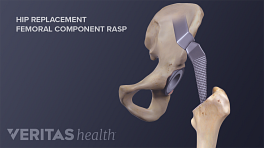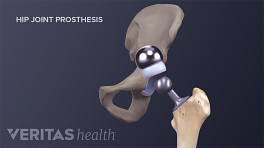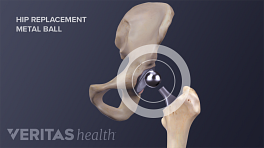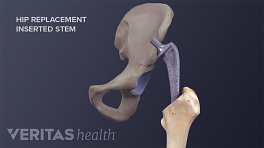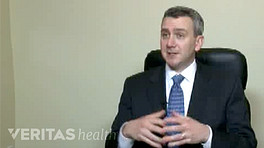Within 24 hours of undergoing hip replacement surgery, most patients are encouraged to walk with the aid of a walker or other assistive device. A nurse or physical therapist will teach patients how to move safely while protecting the new hip as it heals.
Hip replacement patients typically stay in the hospital for 1 to 2 days after surgery. Some people may be able to go home the same day of their surgery if their medical and surgical team feels it is safe to do so. Alternatively, people who need extra attention or do not have home support may be transferred from the hospital to a skilled nursing facility or rehabilitation center.
In This Article:
- Total Hip Replacement for Hip Arthritis
- Indications and Eligibility for Total Hip Replacement Surgery
- Total Hip Replacement Surgical Procedure
- Additional Facts and Considerations for Total Hip Replacement Surgery
- Total Hip Replacement Surgery Recovery
- Total Hip Replacement Surgery Risks and Complications
Movements Hip Replacement Patients Should Avoid (Precautions)
The orthopedic surgeon may give the patient a list of movements to avoid after surgery. The goal of these post-surgical precautions is to minimize the chance of dislocation or other injury to the implant.
Precautions typically address one of two issues:
- Range-of-motion. For example, patients may be advised to avoid crossing their legs or bending deeply at the hip to avoid posterior hip dislocation. (In a posterior dislocation, the thighbone is pushed backwards out of its socket.)
- Weight-bearing. For example, a patient may be told to use crutches or a walker for a period of time (often 6 weeks) if there are concerns about the healing potential of the hip replacement. This allows time for the bone to heal to the implant before too much force (of the full body weight) is placed on the healing bones.
Precautions can vary depending on factors such as the surgical approach (anterior vs. posterior), the patient, and the surgeon’s preference. Some precautions may only apply for the first 6 weeks after surgery, while others—such as running, jumping, and other high impact activities—may apply for the lifetime of the hip.
Physical Therapy
Under the supervision of a physical therapist, a patient will learn stretches and exercises that—
- Speed up healing by promoting blood flow to the hip joint
- Improve the ability to walk, sit down, and do other activities by increasing muscle strength
- Reduce the risk of long-term hip stiffness by preventing the development of scar tissue
Physical therapy typically begins in the hospital. Many people attend outpatient appointments 1 to 3 times a week for 6 to 8 weeks after surgery. Hip stretching and exercises are encouraged even after physical therapy formally ends.
Pain during and after physical therapy
It can be painful to participate in physical therapy. To reduce pain, people may consider:
- Taking pain medications approximately half an hour before therapy
- Using a warm compress before therapy to loosen the joint
- Using a cold compress after therapy to reduce inflammation
Severe and/or worsening pain should be reported immediately to a physical therapist or doctor.
Timeline for Hip Replacement Surgery Recovery
The exact timeline for being discharged from the hospital, stopping pain medication, returning to work, and resuming other activities will vary from person to person. In general:
- Patients should not return to work or do other physical activities without doctor approval.
- Returning to some activities, such as driving, depend on hip function as well as what pain medications are being taken.
- People who have sedentary jobs can typically return to work about 4 to 6 weeks after surgery. 1 Harkess, JW and Crockarell, JR Jr. Arthroplasty of the Hip. Campbell’s Operative Orthopedics, 13th edition. Philidelphia, PA. Elsevier, 2017: 167-321.
- People who need to stand, bend, and lift objects on the job may need to wait about 2 or 3 months.
- Heavy manual labor is not recommended.
- A full recovery may take from 3 months to a year.
A return to recreational physical activity, including yoga, hiking, golf, or other sports, should be done in consultation with the surgeon.
Living with a Hip Replacement
After recovery, people with hip replacements typically report less pain, better hip function, and improved ability to work and socialize. 2 Mancuso et al. Fulfillment of Patients' Expectations for Total Hip Arthroplasty. The Journal of Bone & Joint Surgery. 2009 Sep;91(9):2073-2078.
Physicians typically recommend low-impact aerobic activities such as walking, bicycling (or stationary biking), and swimming or pool therapy. An exercise routine can help keep the hip muscles strong and flexible.
See Ways to Get Exercise When You Have Arthritis
Potential limitations of a new hip
Even after a successful recovery, a replacement hip may be less flexible than a healthy, natural hip. For example:
- Putting on shoes and socks may still require a reaching tool.
- Sitting cross-legged on the floor and other activities that might stress the hip may remain difficult to perform.
- Many, but not all, orthopedic surgeons recommend that their patients limit or avoid high-impact activities, such as running or jumping, which might damage or dislocate a new hip.
Post-surgical results will differ from patient to patient. People are encouraged to discuss reasonable expectations with their surgeons.
See “When Can I…?” Answers for Hip Replacement Patients
Going to the dentist
While the risk of infection decreases as the surgical wounds heal, it never completely goes away. Bacterial infections contracted during dental procedures can affect implants. People who receive joint replacements are advised to tell their dentists before any dental procedure. The current practice guidelines DO NOT recommend prophylactic antibiotics for routine dental cleanings. However, a dentist or doctor may prescribe antibiotics before dental procedures to certain patients who are at high risk for infection.


